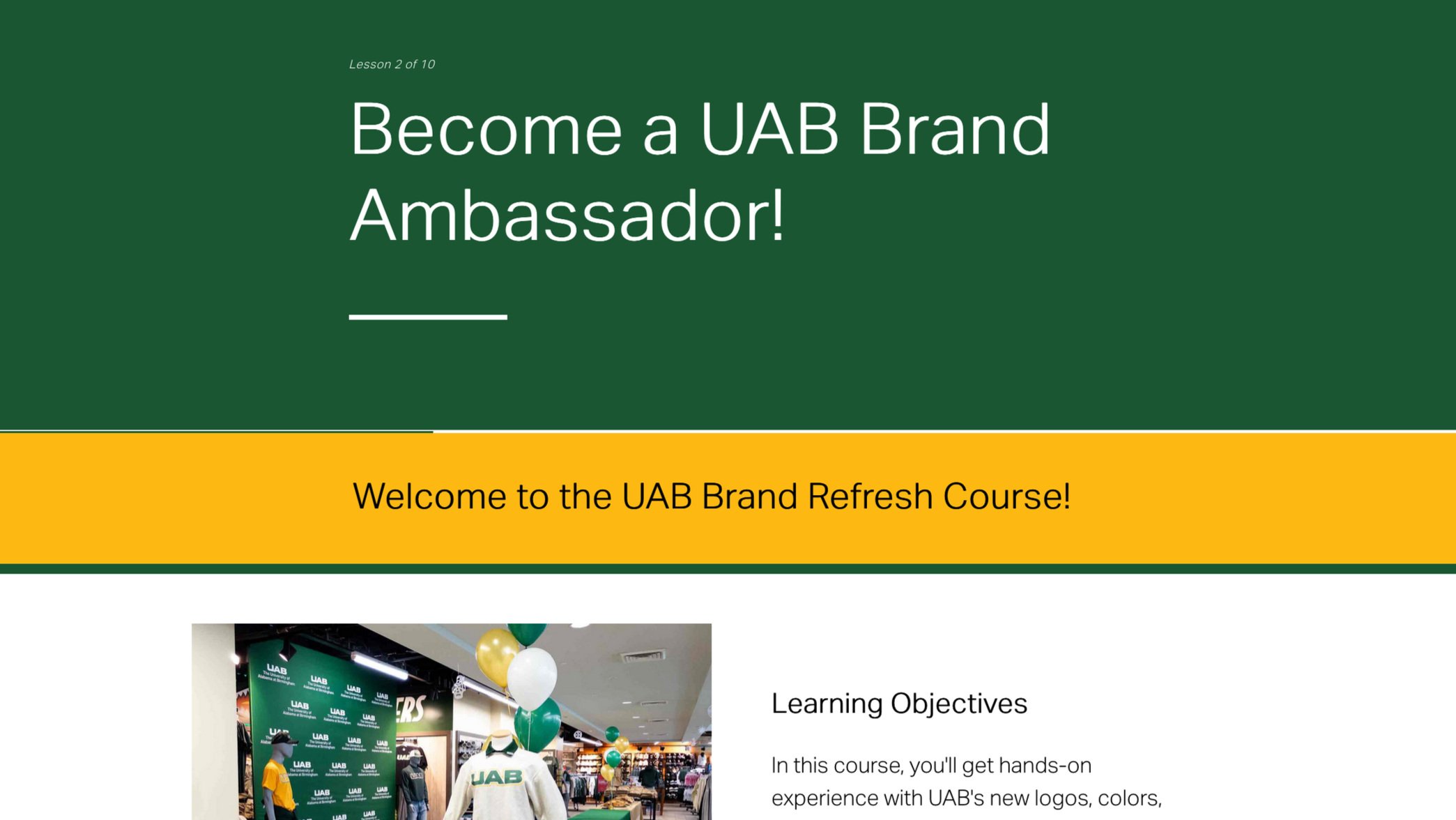UAB Brand Refresh Course
The UAB Brand Refresh Course: Become a UAB Brand Ambassador was carefully designed to instill a sense of ownership, pride, and advocacy among UAB employees as they adopt the new branding. The course is structured to ensure learners not only understand branding guidelines but also actively engage in applying them.
I am passionate about creating this course because, as both a UAB employee and a soon-to-be graduate, I want to contribute to strengthening UAB’s brand identity. This course is an opportunity to help unify the University of Alabama at Birmingham under a cohesive and powerful brand, ensuring it remains recognizable and impactful. By equipping employees with the knowledge and tools to implement branding effectively, we can enhance UAB’s presence and reinforce its reputation across all areas of the institution.
Click on the icons below to see an indepth explanation for each part of the creation process for this course.
-
A significant part of the creation process involved aligning the course with learner needs and professional application. Since stakeholders were involved in shaping the course structure, their feedback helped refine content so that it remained relevant, concise, and practical. One of the key challenges was ensuring that branding information was delivered in a way that avoided unnecessary complexity, making the learning process accessible, engaging, and actionable.
The instructional design approach was highly interactive, integrating scenario-based learning, decision-making simulations, and hands-on activities rather than passive content delivery. Each module follows a structured format:
A video introduction to create context.
Guided explanations of branding elements.
Interactive activities that reinforce key concepts.
Scenario-based assessments to encourage real-world application.
This structure ensures that employees not only learn branding guidelines but also develop confidence in implementing them in their daily work.
-
The course is built upon Cognitive Load Theory (Sweller, 1994) and Constructivist Learning Theory (Piaget, 1950; Vygotsky, 1978), ensuring that content is not just presented but actively constructed by learners through meaningful activities.
Cognitive Load Management:
Branding concepts are broken into small, digestible modules to reduce cognitive overload.
Visual guides, color-coded frameworks, and decision trees aid in quick recall and application.
Instead of overwhelming learners with policy-heavy explanations, key branding elements are introduced gradually and contextually.
Constructivist Learning Approach:
Learning is situated within real UAB branding challenges.
The scenario-based activities require learners to apply knowledge in practical contexts, ensuring retention and long-term transfer.
Interactive exercises, such as decision-making simulations, drag-and-drop activities, and branding audits, allow learners to construct their understanding through hands-on practice.
Multimedia Learning Theory (Mayer, 2001):
Instructional videos integrate visual and verbal elements to enhance learning.
Animated walkthroughs and screencasts illustrate branding principles in action, rather than relying on static content.
-
This course directly aligns with real-world branding challenges that UAB employees face. Ensuring that all materials, presentations, and digital content adhere to UAB’s refreshed brand identity is essential for organizational consistency and recognition. The course is designed to:
Empower employees to confidently implement the new branding by providing clear, actionable guidelines.
Foster brand advocacy, reinforcing why the refresh is essential for UAB’s image and reputation.
Enhance workplace efficiency, reducing errors in branding application and minimizing time spent correcting inconsistencies.
The final Brand Ambassador Certification is an excellent way to motivate participation and instill pride in becoming a UAB brand steward. The checklists, downloadable branding assets, and decision trees provide ongoing support, ensuring that employees can reference materials as needed beyond the training itself.







